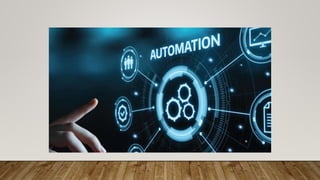
Automation-Rise Of The Machines
- 2. AUTOMATION •Index: • What is Automation? • Open loop Control and Closed Loop Control • Discrete Control(On/Off) • PID Controller • Advantages And Disadvantages • Societal Impacts
- 3. WHAT IS AUTOMATION: • Automation is the technology by which a process or procedure is performed with minimal human assistance. Automation or automatic control is the use of various control systems for operating equipment such as machinery, processes in factories, boilers and heat treating ovens, switching on telephone networks, steering and stabilization of ships, aircraft and other applications and vehicles with minimal or reduced human intervention. • Automation has been achieved by various means including mechanical, hydraulic, pneumatic, electrical, electronic devices and computers, usually in combination. Complicated systems, such as modern factories, airplanes and ships typically use all these combined techniques. The benefit of automation includes labor savings, savings in electricity costs, savings in material costs, and improvements to quality, accuracy, and precision.
- 4. OPEN LOOP CONTROL AND CLOSED LOOP CONTROL: • Fundamentally, there are two types of control loop: open loop control, and closed loop feedback control:: • In open loop control, the control action from the controller is independent of the "process output" (or "controlled process variable"). A good example of this is a central heating boiler controlled only by a timer, so that heat is applied for a constant time, regardless of the temperature of the building. (The control action is the switching the boiler off and on. The process output is the building temperature). • In closed-loop control, the control action from the controller is dependent on the process output. In the case of the boiler analogy, this would include a temperature sensor to monitor the building temperature, and thereby feed a signal back to the controller to ensure it maintains the building at the temperature set on the thermostat. A closed loop controller, therefore, has a feedback loop which ensures the controller exerts a control action to give a process output equal to the "Reference input" or "set point". For this reason, closed-loop controllers are also called feedback controllers. • The definition of a closed loop control system according to the British Standard Institution is 'a control system possessing monitoring feedback, the deviation signal formed as a result of this feedback being used to control the action of a final control element in such a way as to tend to reduce the deviation to zero.’
- 5. DISCRETE CONTROL (ON/OFF): One of the simplest types of control is on-off control. An example is a thermostat used on household appliances which either opens or closes an electrical contact. (Thermostats were originally developed as true feedback-control mechanisms rather than the on-off common household appliance thermostat.) Sequence control, in which a programmed sequence of discrete operations is performed, often based on system logic that involves system states. An elevator control system is an example of sequence control.
- 6. PID CONTROLLER: • A proportional–integral–derivative controller (PID controller) is a control loop feedback mechanism (controller) widely used in industrial control systems • In a PID loop, the controller continuously calculates an error value {displaystyle e(t)}e(t) as the difference between a desired setpoint and a measured process variable and applies a correction based on proportional, integral, and derivative terms, respectively (sometimes denoted P, I, and D) which give their name to the controller type. • The theoretical understanding and application dates from the 1920s, and they are implemented in nearly all analog control systems; originally in mechanical controllers, and then using discrete electronics and latterly in industrial process computers.
- 7. ADVANTAGES AND DISADVANTAGES: The main advantages of automation are: • Increased throughput or productivity. • Improved quality or increased predictability of quality. • Improved robustness (consistency), of processes or product. • Increased consistency of output. • Reduced direct human labor costs and expenses. • Installation in operations reduces cycle time. • Can complete tasks where a high degree of accuracy is required.
- 8. The main disadvantages of automation are: • Possible security threats/vulnerability due to increased relative susceptibility for committing errors. • Unpredictable or excessive development costs. • High initial cost. • Displaces workers due to job replacement.
- 9. SOCIETAL IMPACTS: • Increased automation often cause workers to feel anxious about losing their jobs as technology renders their skills or experience unnecessary. Early in the Industrial Revolution, when inventions like the steam engine were making some job categories expendable, workers forcefully resisted these changes. Luddites, for instance, were English textile workers who protested the introduction of weaving machines by destroying them. • Automation is already contributing significantly to unemployment, particularly in nations where the government does not proactively seek to diminish its impact. In the United States, 47% of all current jobs have the potential to be fully automated by 2033, according to the research of experts Carl Benedikt Frey and Michael Osborne. Furthermore, wages and educational attainment appear to be strongly negatively correlated with an occupation's risk of being automated.[53] Even highly skilled professional jobs like a lawyer, doctor, engineer, journalist are at risk of automation